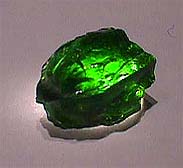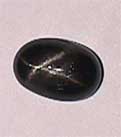A free gemology reference site
Gemology, gemstones, minerals and more
The Gemstones

Diopside
Consumer Information
What color is it?: A beautiful deep green as shown by the rough crystal above is the most often seen faceted version of this gemstone. But as you can see below, diopside also offers a classic four rayed star stone that is very much like a black star sapphire...with the exception that the sapphire will have a 6 rayed star.
What is the story behind this gemstone?: The intensity of the green color of diopside makes it a good imitation of many gemstones that are far more expensive, such as emeralds and tsavorite. Although not seen in main stream jewelry stores, diopside is becoming more and more popular with jewelry designers.
Can I wear it everyday?: Yes, it wears fairly well but can be rather soft for much rough wear.
Is it expensive?: Generally no. About the same as a nice green tourmaline.
Is it a birthstone?: No.
What do I need to know before going shopping?: Again, make sure you are shopping with a jeweler that knows his or her stuff. Diopside is not one of those gemstones that everyday salespeople will know much about. So you will need to seek out a jeweler who is well versed in colored gemstones, and who handles enough diopside to be able to offer you a good selection. Also, if you are shopping for a black star sapphire, be aware that many of the so-called "black stars" that are offered as sapphires are really star diopside. But anyone can tell the difference. Just count the rays of the star. Diopside=4 Sapphire=6. Easy!
General Information
Source: Many world-wide. Most notably India, South Africa, Finland, and Italy
Chemical: CaMg(Si2O6) a calcium magnesium silicate
Formation: Mostly in basic igneous rocks but can also form in metamorphic formations
Crystal System: Monoclinic
Unusual Properties: Asterism (star- 4 rayed)
Gemological Information
RI: 1.675 - 1.701
Birefringence: .026
Optic Character: B+
Specific Gravity: 3.29 + -
Hardness: 5-6
Transparency: TP- Opaque
Special Identifying Properties and Tests: Spectroscope for chromium lines
Synthetics: None at this time.
Imitations: Many possible including glass, epidote, emerald, etc...

